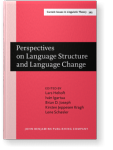Reanalysis in the Russian past tense
The gerundial perfect
The large majority of the Slavic languages have in historical times lost the synthetic past tenses of the aorist and the imperfect. These tenses were replaced by a new past tense based on the erstwhile perfect. This transformation created space for new ways of forming a past tense, and one of these was a novel past tense based on the past active participle, also called the gerundial past tense, a past tense found in Northwest Russia, above all in the Pskov area, cf. Pskov dialectal i jon pom'orši toper’ uže, versus Standard Russia i on teper’ uže umer, ‘and he died now already’. The point of this article is to demonstrate how the emergence of the l-participle as the general past tense opened up for a reanalysis of the past active participle as a finite past tense verb-form. The actualization process following this reanalysis is illustrated by examples from the Pskov Chronicle.
Article outline
- 1.Introduction
- 2.New perfects in Slavic
- 2.1The possessive perfect
- 3.New perfects in Russian
- 3.1The Russian possessive perfect
- 3.2The Russian gerundial perfect
- 4.The source and chronology of the GP
- 5.From secondary to primary predicates
- 5.1Subordination by a finite verb
- 5.2Reanalysis of the secondary predicate
- 5.3Actualization of the reanalysis of the secondary predicate
- 5.4Additional reanalysis and actualization
- 5.5Clause subordination as actualization and extension
- 5.6Interchangeability of predicative participles and the l-participle
- 5.7Completed reanalysis and actualization of the secondary predicates
- 6.Coordination of the GP with present tense
- 7.The morphology of the gerundial perfect
- 8.Conclusion
-
Notes
-
References
